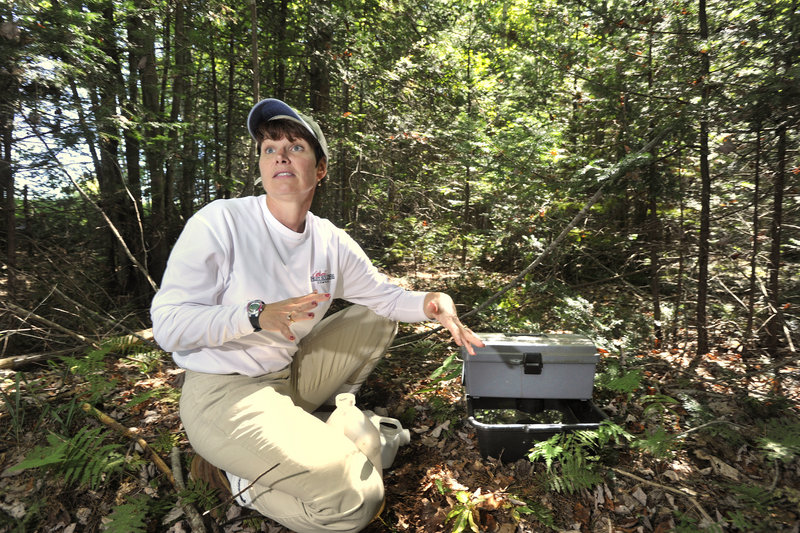Schoolchildren call her “the tick lady.”
But Sherrie Juris, a biologist, does much more than teach about ticks and mosquitoes and how to be protected from the infections they carry — Lyme disease and other tick-borne illnesses, West Nile virus and eastern equine encephalitis.
She’s on the front line of a small army of people that the state of Maine has assigned to gather information on specific diseases where they often appear first: in mosquitoes.
In summer, Juris spends much of her time collecting and counting mosquitoes as part of Maine’s disease surveillance program. With six monitors and 26 stations statewide, the program tracks insect populations to determine whether and where West Nile virus or eastern equine encephalitis has surfaced.
“People don’t realize the legwork” that’s involved in testing insects for infections that can be transmitted to humans, she said.
Juris and other trained site monitors practice a form of science that seems mostly low-tech and very labor-intensive for the critical job of informing the public about the spread of infectious diseases. It’s good science, even if it’s a little reminiscent of early human medicine or 8th-grade science projects.
Juris, for example, uses equipment that includes everything from women’s nylon knee-high stockings to contraptions that call to mind Rube Goldberg inventions, designed from blackened liquor boxes (camouflage), plastic dish tubs (mimicking vernal pools), fishing tackle or tool boxes, PVC pipe, battery-operated mini-fans and covers of giant potato chip cans.
These traps and bait stations are relatively inexpensive essentials that do a reliable job in a crucial task — monitoring mosquitoes for a range of infectious diseases.
Juris keeps track of 40 mosquito traps at five sites in York County. Whether it’s in blistering heat, squalls of rain or balmy breezes, she heads out once a week into the field — more precisely, the forest — to set up traps and bait some of them with “stinky water,” a repugnant blend of rotting straw and standing water.
“You don’t want to spill this in your car,” she said.
The traps operate for one day and one night, in most cases at least 15 to 24 hours, attracting and snaring mosquitoes and other insects. The next morning, Juris returns, collects the mosquitoes and returns to a modest lab in a small cottage in Arundel. She uses a microscope, tweezers and intense concentration to count and identify every single mosquito and separate the whole take into specific genus and species.
“When you look for a while” through the microscope lens, she said, “your eyes get kind of boggly.”
Juris isn’t counting dead bugs. The various traps for mosquito-monitoring harvest live mosquitoes, which are kept in chilled coolers and then transferred to Petri dishes on dry ice. The cold keeps the mosquitoes sleepy.
The state is interested now in testing only six species of mosquitoes, those in which diseases have been found. Juris, who works for Atlantic Pest Solutions in Arundel, a state contractor in the program, records the number, genus and species of the mosquitoes she captures.
Afterward, the insects, dead, are driven to Maine Medical Center in Portland. Once again, the numbers are confirmed and documented, then the insects, frozen and packed in dry ice to preserve their DNA, are shipped off by courier to the health and environmental testing lab in Augusta.
Maine Medical Center is a kind of “bug hub” in the surveillance work: Mosquitoes from all over the state are delivered to the lab there, arriving in test tubes, called pools, containing from one to 50 mosquitoes.
The samples come from the 26 stations — some with several traps — around York, Cumberland, Waldo, Kennebec and Aroostook counties, said Chuck Lubelczyk, a field biologist who supervises the Maine Medical Center portion of the work.
“We like to think of ourselves as flying-on-our-feet scientists,” said Lubelczyk. Describing a small vacuum that sucks mosquitoes into a trap, he said it “involved a lot of tinkering (and) was a long time in the making.”
“It’s a fun science,” he said — a good thing, since the tests detect some sobering illnesses. To make it all work, he said, “we are regular shoppers at hardware stores.”
When the mosquitoes reach their destination in Augusta, they are “ground up, mushed together” before DNA testing is done for specific human and animal diseases, said Sara Robinson, an epidemiologist with the infectious-disease division of the Maine Center for Disease Control and Prevention.
If any test turns up positive for, say, West Nile virus or EEE, it is repeated to double-check the finding, she said. Only when it is re-confirmed is it deemed a clearly positive result and reported to local authorities.
Once local authorities have been contacted, a public announcement can be issued — the end of an intricate, if unromantic, chain of detective work.
“It’s not a glamorous job … but I love this,” Juris said as she vacuumed out a black box during a routine check at the margin of a forested area.
“Yeah, mosquitoes excite me,” she said. “There’s a lot of information that we get from them. They don’t have a voice, but they can speak volumes.”
Staff Writer North Cairn can be contacted at 791-6325 or at:
ncairn@mainetoday.com
Send questions/comments to the editors.



Comments are no longer available on this story